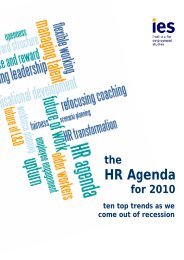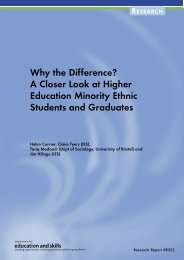Post-16 Transitions: a Longitudinal Study of Young People with ...
Post-16 Transitions: a Longitudinal Study of Young People with ...
Post-16 Transitions: a Longitudinal Study of Young People with ...
You also want an ePaper? Increase the reach of your titles
YUMPU automatically turns print PDFs into web optimized ePapers that Google loves.
equipment available. Although the problems have now been sorted<br />
out and the placement is generally regarded as successful, it took<br />
over half a year for this to happen. Marcus’s mother is philosophical<br />
about the apparent lack <strong>of</strong> preparation, putting it down to the fact<br />
that he is breaking ground for young people <strong>with</strong> PMLD in this<br />
college. On the other hand, the difficulties <strong>of</strong> the transition process<br />
had taken a toll on her mental health and had left her <strong>with</strong> a<br />
negative view <strong>of</strong> how that process had been handled.<br />
Where there has been turbulence in, or a complete breakdown <strong>of</strong><br />
schooling pre-<strong>16</strong>, transition planning inevitably suffers. Li, for<br />
instance, is a young man <strong>with</strong> moderate learning difficulties,<br />
though these are compounded by his lack <strong>of</strong> confidence, by the<br />
fact that he does not speak English at home (he is <strong>of</strong> Chinese<br />
ethnic origin) and by some apparent social difficulties. He had no<br />
statement, but towards the end <strong>of</strong> his schooling, his comprehensive<br />
school placed him in a Pupil Referral Unit. He was not happy there,<br />
felt he was bullied by other pupils and did not get on <strong>with</strong> the<br />
teachers, so he stopped attending. As a result he had little or no<br />
preparation for transition – or at least, none that had any impact<br />
on him. Since his parents spoke little English, they were in no<br />
position to advocate on his behalf and Li was thrown back on his<br />
own resources to sort out his future. He eventually found his way<br />
onto a painting and decorating course at an FE College. His<br />
account <strong>of</strong> how this came about is illuminating:<br />
‘One <strong>of</strong> my friends showed me because he was at the<br />
college and he came to see me and he said there is a course<br />
going on and I ought to join and I thought I had to fill out all<br />
these forms, but I didn’t fill out any forms, I just jumped on<br />
the course and the teacher said it was alright.”<br />
What is significant here is that the formal processes <strong>of</strong> preparation<br />
and planning for transition were <strong>of</strong> little significance for a young<br />
man who was progressively disassociating himself from schooling.<br />
His choice is determined not by pr<strong>of</strong>essional support and rational<br />
decision-making, but by his own lack <strong>of</strong> confidence and the<br />
influence <strong>of</strong> his friends.<br />
Making sense <strong>of</strong> the range <strong>of</strong> experiences is difficult, not least<br />
because families and pr<strong>of</strong>essionals sometimes gave very different<br />
accounts <strong>of</strong> the same events while some young people were<br />
unable to give coherent accounts <strong>of</strong> what had happened to them.<br />
Nonetheless, some themes are clear. Above all, in this sample at<br />
least, the smooth, planned transition process is the exception<br />
rather than the rule. Although there is evidence <strong>of</strong> plans being<br />
made and schools doing all they had to do in terms <strong>of</strong> organising<br />
reviews, involving parents and co-ordinating the inputs <strong>of</strong> other<br />
agencies, the process worked best where least was at stake. In<br />
other words, if all were agreed that there was no real option<br />
beyond staying on at school, the transition process was effectively<br />
deferred for two or three years and the young person continued<br />
along a pre-ordained track.<br />
Elsewhere, a range <strong>of</strong> factors disrupted the transition process. For<br />
some young people, there was no real choice and the single option<br />
on <strong>of</strong>fer may or may not have been appropriate. For others, there<br />
48 <strong>Post</strong>-<strong>16</strong> <strong>Transitions</strong> <strong>of</strong> <strong>Young</strong> <strong>People</strong> <strong>with</strong> SEN: Wave 2

















